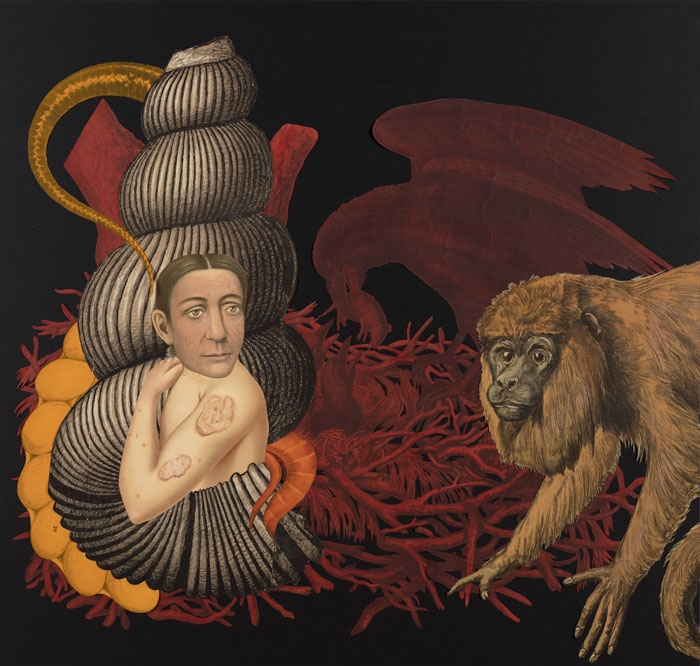If you’re thinking of being laid to rest in a coffin, consider a biodegradable death suit instead. Footed and mitted, Jae Rhim Lee’s Coeio – Infinity Burial Suit (2016) might resemble a set of snuggly adult pyjamas, but the material is woven with the spores of a flesh-digesting mushroom which speeds up decomposition and neutralises any toxins released from the rotting body. Environmentally conscious burials are not new but Jae’s concept, which embraces morbid-sounding scientific research (she fed bits of her hair, nails and skin to various mushrooms to determine the most efficient strain) to achieve an ashes-to-ashes ideal, is refreshing. The suit, available to buy online for US$1,500, inaugurates a new fashion category: eco-friendly, post-mortem wear.
The blithe weirdness of this product is typical of an exhibition that draws on science and art to consider the world from a less anthropocentric perspective. The posthumanism of its title is a broader philosophical project that challenges the universalist status of the human subject and its separateness from nature, and its selection is generally utopic, proposing alternatives for a more diverse and interconnected world. A section features works that are part art-installation, part-functional design, aimed at improving human lives while minimising environmental damage. These include a portable water purification device that looks like a water wheel (Lucy + Jorge Orta’s Orta Water – Portable Water Fountain, 2005) and a series of procedures to transform wastewater from tofu and tempeh production into useable materials (Irene Agrivina’s Soya C(o)u(l)ture, 2014). How practical and scalable these projects are remains to be seen, but they are prototypes for an optimistic model of urban life with less wastage and pollution and better access to resources.
Another recurring interest in the show is in forms of knowledge beyond anthropocentric, scientistic frameworks. This includes recognising the agencies and intelligences of other species, illustrated by Thai design practice Animali Domestici’s colourful tapestry of the country’s capital with snakes, pigeons and rats sharing the streets with humans (Bangkok Opportunistic Ecologies, 2019). Indigenous systems of understanding also get a look in with Marjetica Potrč’s Earth Drawings (2009-2016), which depict the cosmologies of communities in Australia, Norway and the Amazon in beautiful mind maps linking ideas, origin stories and places.
Most of the works here promote neighbourly co-existence with other species, but the more exciting ones blur the line between humanness and animality, culture and nature – another key posthuman trope. Pierre Huyghe’s Untitled (Human Mask) (2014), a 19-minute video featuring a monkey wearing a noh-inspired mask wandering around an abandoned restaurant in the Fukushima restricted area, is a hypnotic, disturbing and at times weirdly touching classic of the genre. In different lights the macaque resembles a deranged woman, a restless child and a trained primate whose real face and nature remain a mystery. By mimicking human actions and yet not quite achieving perfect mimesis, the monkey invites and repels empathy. The video has been interpreted as portraying the inevitable subjugation of animals to an anthropomorphic gaze and emphasising the divide between human and animal consciousness. Yet the monkey’s playacting, the theorist Ana Teixeira Pinto has argued, also suggests that humanness is, like gender, at least partly performed.
Nicholas Mangan’s Termite Economies (Phase 1) (2018) features another kind of interspecies collaboration. Mangan was inspired by a true story of Australian scientists researching the possibility of using termites to discover gold deposits, and created scale models of what these termite mines may look like. Rickety, soil-coloured and filled with skinny spirals, the structures blend insect architecture with the underground tunnelling systems of human mining sites. Some of them, their forms generated by swarm software, look like honeycomb cells. Others, with their cockscrew tunnels, evoke theme-park waterslides. But then again, I’m looking through human eyes. A complete paradigm shift might mean abandoning such analogies altogether, a more radical undertaking for which this exhibition is only a starting place.
The Posthuman City at NTU Centre for Contemporary Art, Singapore, 23 November – 8 March
Published online 3 January 2020
